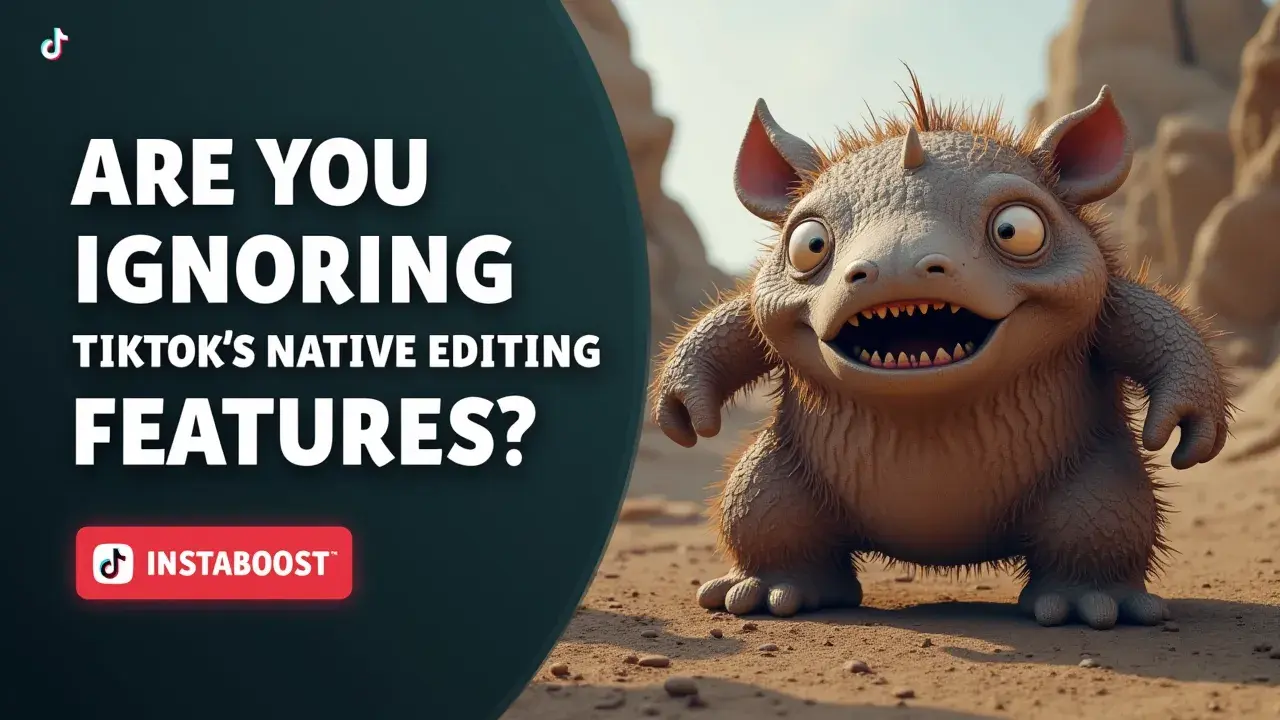Are You Overlooking TikTok’s Native Editing Features?
Native TikTok tools can boost reach, retention, and production speed when aligned with how the platform surfaces and audiences consume content. In-app effects, text timing, and sounds integrate tightly with discovery and keep viewers engaged. Complex storytelling or brand-specific templates may still suit an external NLE, especially for precision control and versioning. A smart path blends quick native edits for platform signals with NLE polish where depth and consistency matter.
The Edit TikTok Actually Reads
Most creators still cut in Premiere or CapCut, export, drop the final into TikTok, add a caption, and call it done. TikTok doesn’t only see a finished clip; it parses the edit. When you use TikTok’s own tools – on‑screen text, stickers, auto‑captions, even text‑to‑speech – inside the app, those elements become time‑coded signals tied to your audio and keywords. They’re not decorations. They add context the ranking system uses. Native editing often improves indexing and retention, which is why imported reels can look clean but still lag.
A simple setup works – think of it as a small TikTok profile upgrade you make on the timeline: put your hook as in‑app text at 0:03, drop a keyword sticker during the demo, and add short chapter labels that land on the beat. Now TikTok has clear anchors for topic detection and audience matching. Even basic moves help: use auto‑captions and fix the wording, pin a label when you show the result, or let text‑to‑speech read the hook so the timing is exact.
Because these pieces live on the timeline – not burned into the pixels – they’re indexable. This also feeds TikTok SEO: clearer captions, more searchable terms, and tighter alignment between what’s said and what’s on screen. For viewers, these touches make the story easier to follow. For the model, they’re structured data that helps predict who will finish, rewatch, or share. This article isn’t about trendy effects. It’s about using the native editor to speak the platform’s language without losing production polish. We’ll look at where native beats off‑platform tools, how to time text and cuts so signals stack, and what to tweak when repurposing so strong ideas stop getting buried. If your crisp exports keep stalling, the fix usually isn’t a louder hook; it’s giving TikTok more to read, right where the viewer needs it.

Receipts, Not Hype: Why Native Edits Win
You can fake confidence, but not outcomes. After enough side‑by‑side uploads, I stopped debating “quality” and started watching what the app can actually read in its own data. When the only variable is editing inside TikTok – on‑screen text timed to the beat, auto‑captions on, a sticker that lands where the offer’s on screen – those posts consistently get a search label above the video, pull Search traffic in Analytics, and keep people at the moments where those native elements appear. Export the same piece (same script, same hook, same thumbnail) and it might catch some For You exposure, but it rarely earns that search label and almost never fills Related searches.
That isn’t a mystery; the ranking model is picking up time‑coded signals it can align to the audio and the keywords, and I still see teams buy tiktok followers like that will fix discovery. Native tools turn your words into structured, frame‑level metadata the indexer trusts. Off‑platform edits show up like a flat file – nice visuals, thin context. If TikTok SEO matters to you, feed the crawler: put primary keywords in text layers (like “how to clean white sneakers” right where you show the scrub), keep auto‑captions on for coverage, and drop a sticker or TTS exactly where you want a retention bump or a conversion nudge. The return isn’t only reach; it’s intent. You start showing up for the questions you actually answer, not the broad topic your video resembles. That’s credibility the system can verify – and your audience can tell.
Strategy: Build for TikTok’s Parser
Strategy isn’t a checklist; I treat TikTok’s built-in editing tools as structure, not decoration. I start by choosing a search intent I can realistically win – think “how to fix patchy eyeliner” instead of “beauty tips,” or “how to clean white Converse” instead of “shoe care” – not vague ambitions like “how do I grab tiktok likes”; I say that exact phrase in the hook and put the same words on screen in the first second. I break the script into three timed beats: problem, mechanism, payoff. For each beat, I add a short text overlay that repeats the main keyword or a close variant, and I keep auto-captions on so the audio and text line up.
If there’s an offer or a step someone needs to catch, I pin a simple sticker at the moment it appears; that timestamp becomes a data point the model can read. I don’t bake text into exports – I write it natively so TikTok can parse it and surface the search label and Related searches. I keep a reusable in-app template – consistent font, placement, and pacing across posts – so production stays quick without losing native signals. In Analytics, I check Traffic Source for Search and watch retention at the exact moments my overlays land; if I see a drop right before a beat, I tighten the line or move the sticker a touch earlier. To me, this is TikTok SEO: mapping language to time-coded moments the system can recognize, not polishing a video and hoping it hits. I design for the parser first and the timeline second, because the app doesn’t rank intentions; it ranks what’s time-stamped.
Pushback: Pretty Isn’t Parseable
It can feel isolating when you stop chasing polish and start building for TikTok’s parser. You’re pushing against habit: the After Effects templates your editor loves, the brand deck’s lower‑thirds, the reflex to export from Premiere and “distribute everywhere.” I’m the one in the room saying: cut inside TikTok. Put the exact search phrase on screen in the first second (for example, “how to clean white sneakers”), let auto‑captions run, and pin a sticker to the object when you say the offer. It looks less “professional,” but professionalism doesn’t rank; parseable, time‑coded signals do.
Native edits give the model synchronized cues – text, captions, sticker coordinates, sound – that map to intent and carry people through the beat where the answer lands. Imported reels look fine, but they show up stripped of those micro‑events, so they rarely pull a search label or populate Related searches. If you want proof, run a week of paired uploads and track TikTok SEO metrics, not vanity views or cheap tiktok views: search terms triggered, watch time at caption spikes, tap‑throughs from the search badge.
Then write rules. Non‑negotiables: one winnable intent per clip; the exact phrase said and shown; three beats (problem, mechanism, payoff); at least one pinned visual aligned to the payoff moment. Save the cinema for your brand film; your ranking videos should read like structured data in motion. It’s lonelier to keep advocating for native editing, but the payoff compounds as the system learns your phrasing, cadence, and visual anchors, and starts to catch the way you talk and point.
Commit to Native, Win the Parse
It probably didn’t end the way you expected because you optimized for looks instead of the system that decides who sees you. Don’t split the difference next time. For your next post, pick one winnable query – like “how to clean white sneakers” – and make the whole thing inside TikTok. Put that exact phrase on screen and say it in the first second. Keep the hook to two beats. Let auto‑captions run.
Drop a sticker the moment you mention the cleaner or method. Cut your B‑roll so it lands on the word that names the object. In the caption, repeat the phrase once and add a single plain‑English tag; skip the hashtag soup. I think of it as TikTok SEO for humans: time‑coded words, not vibes.
Then measure like an editor, not a marketer. In Analytics, watch Search appearances, 3‑second views, and average watch time by traffic source. Read the auto‑captions to make sure they caught your keyword, and check if viewers scrub to the payoff. Tomorrow, run the same query with one change – try a different opening verb, an earlier sticker, or a tighter beat of silence – and look for a lift. If imported reels keep lagging, don’t try to “fix” them; retire them. The platform is telling you what it can parse.
When you use TikTok’s native tools as the structure, the video reads clearly, gets ranked, and gets replayed – and if distribution’s on your mind, there are ways to spread TikTok content wider – the real win isn’t prettier videos; it’s clearer signals that compound. Ship three iterations in a week and you’ll feel the shift in discoverability, saves, and steady, compounding search traffic.















